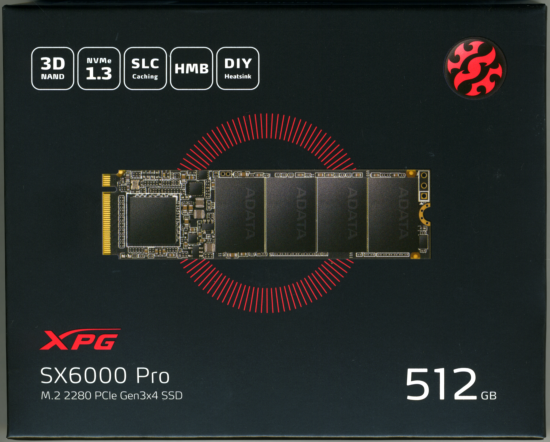The XPG SX6000 Pro comes in a small black box. Along with a picture of the drive, the front advertises many of its key features including its 512GB capacity, PCIe Gen3x4 interface, NVMe 1.3 support, SLC caching and 3D NAND. The back of the box provides a bit more information regarding the SX6000 Pro's features and performance. Inside, you'll find the SSD as well as a black, aluminum heatsink that can be attached to the drive.

Physical Features:
The XPG SX6000 Pro uses the 2280 form factor for M.2 (NGFF) SSDs. It measures 22 x 80 x 2.15 mm and tips the scales at a mere 8g. The drive also has an "M key" edge connector which provides PCIe SSDs with up to 4x lanes of bandwidth.

Like ADATA's SX6000 Lite SSD, the SX6000 Pro uses Realtek's new RTS5763DL controller. There isn't a lot of information available regarding this controller but after talking to Realtek we learned that this DRAM-less, PCIe Gen 3 x4 controller supports four channels with up to four chip enables (CE) per channel. The RTS5763DL is also compatible with 3D TLC/QLC NAND flash and offers features like AES 256-bit encryption, advanced low-density parity check (LDPC) technology and end-to-end data path protection.


For the 512GB version of the SX6000 Pro, ADATA has opted to use their own 3D TLC NAND flash. Looking at the picture above, you can see that there are four 128GB NAND flash packages on top of the PCB. Also take note that there is no DRAM cache chip. The SX6000 Pro's RTS5763DL controller takes full advantage of NVMe's Host Memory Buffer feature by using a small portion of the computer's memory to cache the mapping tables.

The aluminum heatsink included with the SX6000 Pro is simple, yet functional. It attaches to the top of the drive using thermal adhesive and does have a small, yet measurable, impact on temperature. I found that with the heatsink installed, the SX6000 Pro's temps dropped by a few degrees during idle periods and heavy workloads.



